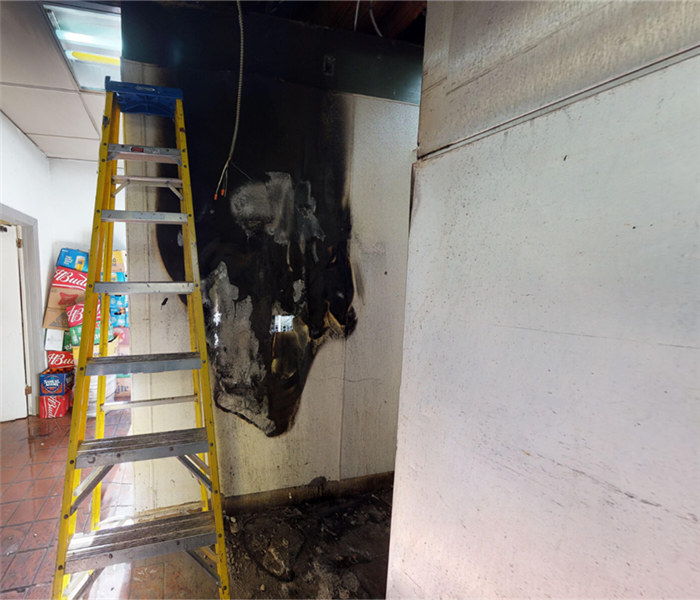Top Causes of Restaurant Fires in Old Saybrook
9/29/2020 (Permalink)
 The fridge in this restaurant caught fire, but luckily the fire suppression system kept it contained until the fire department arrived.
The fridge in this restaurant caught fire, but luckily the fire suppression system kept it contained until the fire department arrived.
A fire in your restaurant is completely devastating. Getting a call at 4 AM that your restaurant just burned down is a call no business owner wants to receive. But when there are roughly 7,500 structure fires in eating and drinking establishments across America every year that cause $165 million in property damage, a disaster can be more likely than you think.
The best way to ensure a fire never happens in your Old Saybrook restaurant is to know how they start. This way, you can take steps to prevent them from happening and minimize damages if a fire does start.
How Do Restaurant Fires Start?
They are many different parts of a restaurant that could become a fire hazard when not properly used or maintained. The following are the top causes of restaurant fires:
Cooking oil
Unsurprisingly, cooking materials like fats, oils, or food were the first items ignited in 43% of fires in restaurants. When food or oils are cooked at too high of a temperature, they can catch on fire. Sometimes a fire in the kitchen is desirable - but grease fires are not. Take care when cooking in your kitchen - a surprise fire can happen to even the most experienced chefs.
Grease traps
Since the oils and fats that are used in cooking can clog sewers and cause major backups, it is required for restaurants to keep oils in a container to keep them out of the sewer system. This can sometimes be a large underground metal container, or a container on the exterior of the building. When these are not cleaned out within the recommended time frames, they can become a huge fire risk.
Exhaust system & ductwork
When a fire starts on the stove, it can quickly spread throughout the entire structure through the exhaust and duct system. This is because oven hoods above stoves take in hot cooking air and redirect it outside. This air also contains grease and oil particles from cooking that will build up over time. When the exhaust system of a restaurant is not properly maintainenced every so often, they can be a huge culprit of starting or spreading a fire.
Gas leaks
Many chefs prefer gas ranges to evenly cook their delicious meals, but this can also be a fire hazard. When equipment gets older or is neglected, they may not be able to support the flow of gas and will cause a leak. When a gas leak isn't noticed, something as simple as turning on a lightbulb can spark a fire.
Electrical Issues
Electrical fires can start when unsafe wiring, sockets, or plugs heat up flammable or combustible items. If your kitchen has outdated wiring that can't handle the voltage of modern cooking equipment or the volume of equipment plugged in, items may spark, short circuit, or overheat - leading to a fire.
Preventing Restaurant Fires
The biggest key to prevent a fire in your restaurant is to take regular maintenance seriously. Perform all required or suggested cleanings of your appliances, exhaust system, or grease traps. If you know you may have an electrical problem, remedy it right away.
According to the National Fire Protection Agency, 68% of fires in eating or drinking establishments were small and did not spread beyond the object of origin. This means that having the proper fire suppression equipment is highly useful in preventing fires from spreading. Be sure to have a fire extinguisher in the kitchen along with any other places as required by law, and keep it up to code.
Investing in a fire suppression system is helpful in combatting damages if a fire does start in your restaurant. Suppression systems connect to both the hood over your cooking station and the gas line running through it. If the fire suppression system is tripped, the gas will automatically turn off, killing the fuel source for the fire.
If the fire continues to burn, the nozzles installed in the hood over your cooking station will discharge a fire suppressant that is designed to combat even grease fires. As the fire creates smoke, the hood also turns on to remove smoke from the kitchen.
Although many of the ways to prevent a fire are costly, they are worth it to keep your business up and running.






 24/7 Emergency Service
24/7 Emergency Service